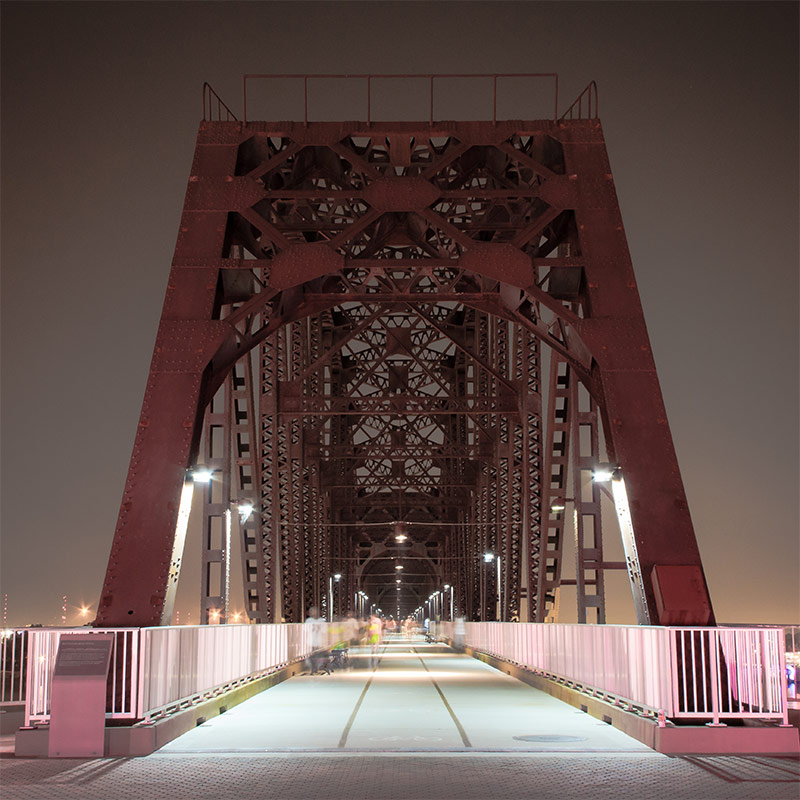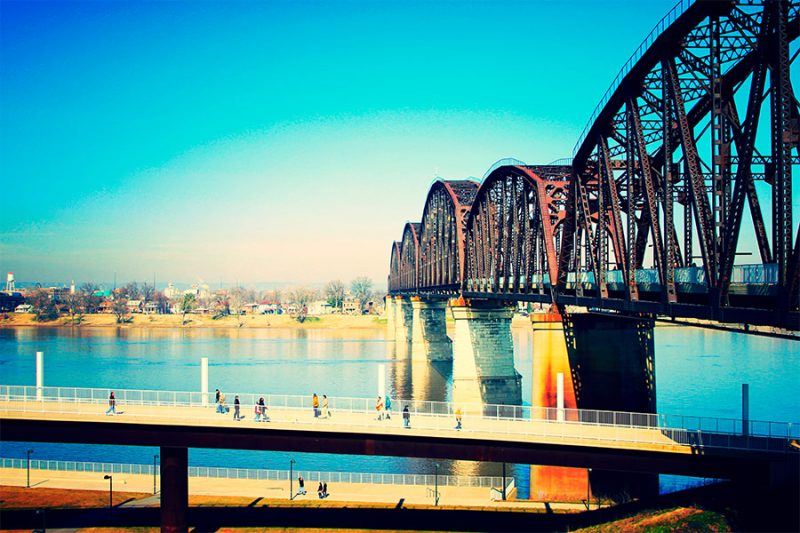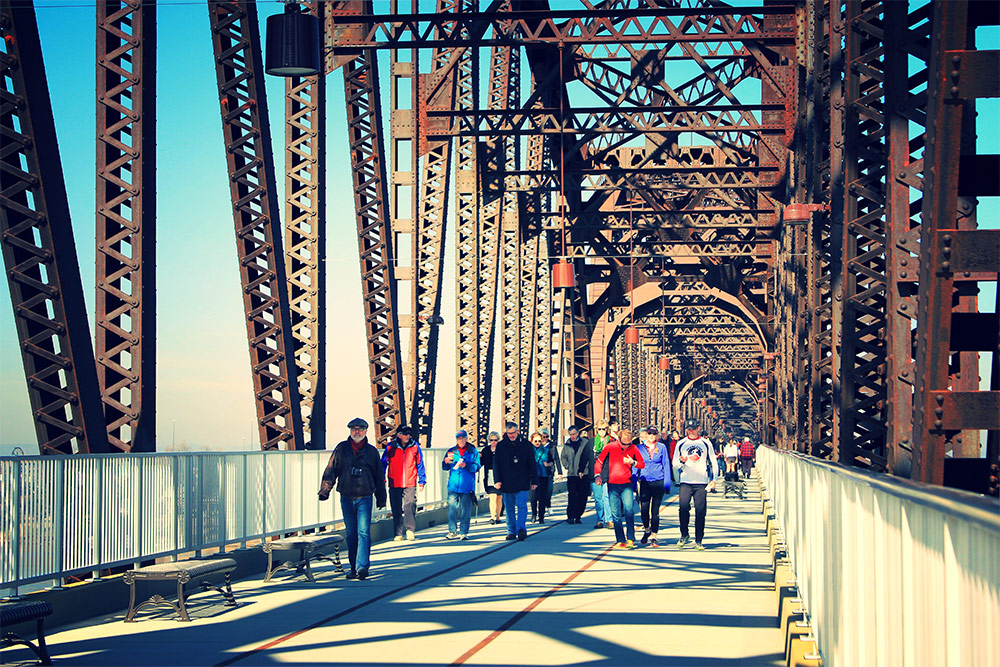Less than a month ago, Mayor Greg Fischer stood in front of Metro Louisville’s 265-member snow team and declared the city ready for this year’s snow season. But that apparently only applies if you’re on a street built for cars.
WAVE3 reported on November 19 that pedestrians and cyclists who rely on the Big Four Bridge to cross the Ohio River are out of luck if there is snow or ice present on the bridge this winter—the Waterfront Development Corporation (WDC) will barricade the bridge rather than salt or plow. “There was never an intent to put chemicals on or to scrape it,” David Karem, WDC president, told WAVE3. “This is a bridge that is not part of the Kentucky highway transportation system,” he continued. “It’s an amenity now. So when it comes to maintenance and repairs, we’re on our own.”

But Karem said the bridge closures won’t be strictly enforced. Instead, pedestrians and cyclists can take their lives into their own hands and cross the ice-covered bridge at their own risk. “We’re not gonna have brigades out to keep you off of it,” Karem told WAVE3. “But it [closing the bridge] is saying you’re at your own risk, and I think most people understand that.”
This isn’t the Waterfront Development Corporation’s first slip-up with bicycle policy. In August, the WDC removed sharrow markings from the center of the bridge and threatened to ban bike riding on the bridge entirely. According to the Courier-Journal, WDC vice-president Mike Kimmel said the impetus was his personal observations of some cyclists being rude while crossing the bridge. “We have been intrigued by a profound sense of entitlement that a designated bike lane engenders,” Kimmel told the C-J‘s James Bruggers.
Given the Big Four Bridge is one of two Ohio River crossings for pedestrians and cyclists—the other being the notoriously dangerous Second Street Bridge—this policy is unacceptable for a city trying to bolster its bike-friendly image. Further, the Big Four Bridge was funded by the Ohio River Bridges Project as a cost-savings alternative to the federally-mandated pedestrian and cyclist component of the project, a move that was applauded by the likes of Karem.
During the budget-cutting phase of the Ohio River Bridges Project, a pedestrian and cyclist path attached to the new Interstate 65 bridge was eliminated in favor of the Big Four Bridge conversion, which was already planned just upriver of the highway bridge. According to a letter sent from INDOT project manager, Ron Heustis, and KYTC project manager, Gary Valentine, to the Federal Highway Administration on April 16, 2012:
In order to reduce project costs, the Modified Selected Alternative was developed which includes the removal of the bicycle/pedestrian path on the new I-65 northbound bridge because the nearby Big Four Bridge, a former railroad bridge, was being developed as a new bicycle/pedestrian path.
That letter continues (emphasis added):
In comparing the two options, it has been determined that the Big Four Bridge would provide, at minimum, the same service, function, and benefits as the bicycle/pedestrian path proposed as part of the FEIS Alternative for the new I-65 northbound bridge.
Louisville can’t afford to keep wrestling with these ill-conceived policies regarding pedestrians, cyclists, and the infrastructure that supports them. The WDC has done a wonderful job building a park and completing the Big Four Bridge conversion, but these gaffes are demonstrating that it may not be the best organization to operate a major bi-state transportation thoroughfare for pedestrians and cyclists.
To be fair, the move to close the bridge is a joint decision of the WDC and Jeffersonville’s Redevelopment Commission. “We don’t want to have problems with people slipping and falling and heavy wind that you have up on there,” Rob Waiz, Jeffersonville Redevelopment Director, told WAVE3. “We’ll be working together on this.” The collaboration is off to a rough start, WAVE3 reported, as barricades were recently installed on the Louisville side, but no barricades were put in place in Jeffersonville during a recent icy day.
To reach a solution here, both Jeffersonville and Louisville officials must recognize that the Big Four Bridge is not an amenity—it’s a crossing that people on both sides of the river rely on to get around, whether that’s for recreation, for work, or anything else.
Next, if the Big Four is meant to maintain at least the level of service of a facility provided with an interstate highway bridge, let’s treat it as such. We shouldn’t require parks departments to fund the maintenance of such a transportation facility. Instead, other agencies who are experienced with and equipped to remove snow and ice should be tasked with clearing the bridge. For city-controlled roads in Louisville, Metro Public Works clears snow and ice.
According to Metro Louisville:
City snow routes are major roads, school and TARC bus routes, arteries to major local employers and hospital and emergency routes. The Kentucky Transportation Cabinet and private contractors clear about 600 miles in the city, and the remaining 1,000 miles are neighborhood streets that are only cleared when a snow emergency has been officially declared.
As a part of an ongoing agreement with the Kentucky Transportation Cabinet, city crews will treat and clear state roads other than interstate highways—about 400 miles of roads—in Louisville. The state will continue to clear all interstates and ramps.
With so many miles being cleared by the city and state, it seems like a minor request to add one more mile along the Big Four Bridge. Fortunately, there may be a resolution coming in the new year. Waiz told WAVE3 that his agency plans to issue a request for proposals from private contractors for cost-estimates to maintain the bridge in winter months. A decision based on that RFP could come in January.
Still, Louisville and Jeffersonville must stop waiting until the eleventh hour to address important issues relating to pedestrians and cyclists, especially on a project that has been as important—both at promoting walking and biking but also as an economic driver—as the Big Four Bridge. If the agencies tasked with overseeing the bridge and its maintenance are unable to create appropriate policies that govern its use and maintain an appropriate level of service for its users, then it’s time we find an agency that can.




Okay. Your point about the WDC being all wonderful about restoring the bridge and making it usable for foot and bike traffic – oh, except in the winter, when it would be DANGEROUS – but need to be fired in favour of some other entity that isn’t as safety-conscious, just so you can bike it across the river, is heavily flawed.
I would much rather have the bridge closed in the winter months – you know, when we have snow and high winds that can turn that snow into ice, which is slippery, by the way – than hear or read a news story about how some dumb sap slid and fell off his bike, fell off the bridge and drowned because he or she couldn’t arrange to cross the river some other, safer, way.
But you’re the editor of this site, so you probably know better about city infrastructure and safety than people who are hired for that kind of thing.
@Hunter S Kittenn – Let’s turn your argument around: Would you suggest we close the new I-65 bridge under construction during the winter months when we have snow and high winds that can turn that snow into ice, which is slippery. Wouldn’t that be better than potentially hearing a news story about how some dumb sap swerved and crashed his or her car, potentially killing himself or herself, or worse, someone else? That seems like a laughable line, right?
There’s a reason the multimodal path is required as part of the federal approval process for projects like the ORBP—to give options on how to get somewhere. It’s a symptom of a community that doesn’t support cycling and pedestrians when the infrastructure that supports them is treated as mere toys. You don’t have to use the bridge in Winter months. Someone else might want to—or need to.
Moreover, by closing the bridge but saying “cross at your own risk” as the WDC is doing, you’re more likely to see someone injured than if the WDC, city, or state treated it as any other thoroughfare in the city. This is not a park amenity, it’s a street for bikes and pedestrians.
@Hunter S Kittenn –
Have you actually used the pedestrian bridge? Do you realize how absurd this hypothetical scenario sounds?
It’s funny how a thing that is supposed to enhance our city and reflect a long absent commitment to cyclist and walkers…doesn’t. It is really like three separate elements…cyclist, walkers and non-cyclist are arguing about something with such an easy solution. Hunter S Kittenn’s opinion is the prevailing one that is widely held in both Louisville and Jefferson County. He quite obviously does not bike as manifested by his need to call those who do…”dumb saps”. I have biked thousands of miles and I assume as much risk biking on the Louisville Loop as I do crossing the bridge. There is a significant animosity between cyclist and motorist on the streets of Louisville despite a push to have dedicated “non-protected” bike lanes. One would think a pedestrian/cyclist bridge would be different and at least they could co-exist. However, apparently not, as walkers could not understand the concept of a well marked designated bike lane which was abandoned as a second thought to solve the problem. The solution is simple…either close it and completely restrict access on both sides in inclement weather or maintain and take care of it. The idea that it become a “3 season” bridge in light of it’s purpose and amount of money spent is absurd.
I think this closure policy is a violation of something, somewhere, within the ORBP requirement for multimodal transportation. But more specifically, I’d be curious to know if there’s any actual data on whether or not winter weather has presented any problems for cyclists of pedestrians on the Big 4. I walked it several times last year in snow and never once fell off, nor did I see anyone else fall off.
Thank you Brandon for telling the truth. It is about high time someone tells the public the truth. I commute across the Big 4 Bridge about 3 times a week for work. The second street bridge is still not repaired for bicycle travel. This city has never been bicycle friendly and there is no such thing as pedestrian/cyclist bridge. Its all in favor of the fat lazy cry baby pedestrians who also get there way whether they are walking or driving. Let the circus begin on the bridge and soon it will be the entertainment arena for all the pedestrians to perform their circus acts. This bridge is certainly not for travel which it was intended for. Mr. Kimmel of the WDC is part of the problem not the solution.
I think the main part of the bridge should be for Bike lane . We have a lot of bikers on both sides and it will draw money in to both parts of our city . Not promoting bikes is a big mistake. So I hope we will try to give bikes it’s lane and walkers it’s lane .